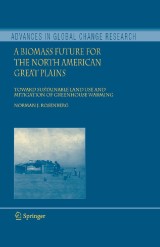Details

A Biomass Future for the North American Great Plains
Toward Sustainable Land Use and Mitigation of Greenhouse WarmingAdvances in Global Change Research, Band 27
|
96,29 € |
|
| Verlag: | Springer |
| Format: | |
| Veröffentl.: | 15.02.2007 |
| ISBN/EAN: | 9781402056017 |
| Sprache: | englisch |
| Anzahl Seiten: | 198 |
Dieses eBook enthält ein Wasserzeichen.
Beschreibungen
WHY THIS BOOK? This book is an exploration of the possibility that a significant portion of the North American Great Plains (NAGP), now primarily in rangeland, corn, soybean, and small-grain production, can be converted to the production of biomass-energy crops. Biomass can be used as a substitute for some of the fossil fuels the use of which is now increasing the atmospheric concentration of carbon dioxide (CO ) 2 and contributing to global warming and climatic change. Such a land use change to biomass could lead not only to a global good but also to specific economic and environmental benefits for the NAGP region. This analysis is prompted by the following facts and trends: The emission of CO from fossil fuel combustion and tropical deforesta- 2 tion and the rising concentrations of other greenhouse gases make global warming a virtual certainty in this century; indeed the evidence is strong that a warming is already discernible. Global warming will lead to climatic change and, while the geographic d- tribution of this change is not yet known, most general circulation models (GCMs) suggest that midcontinental regions in the northern hemisphere (such as the NAGP) are likely to become drier as well as warmer. NAGP, one of the world’s major breadbaskets, is subject to periodic droughts and other climatic stresses that may worsen with global wa- ing.
The Physical Environment.- People and the Economy.- Agriculture and Sustainability.- The Wildcard of Climate Change.- A Role for the Plains in Combating Climate Change.- Outlook.
<P>The author is Regent's Professor Emeritus of Agricultural Meteorology at the University of Nebraska-Lincoln and Laboratory Fellow Emeritus at the Joint Global Change Research Institute, a collaboration of the Pacific Northwest National Laboratory and the University of Maryland-College Park.</P>
<P>The Great Plains of North America is a major global breadbasket but its agriculture is stressed by drought, heat spells, damaging winds, soil erosion and declining ground water resources. The great inter-annual variability in crop production and declining rural populations weaken an economy already highly dependent upon government support. The region’s ecological fragility and economic weakness is attributed by many to removal of its original grass cover. Abandonment of agricultural cropping and restoration of the grass cover is one proposed solution to the region’s problems.</P>
<P></P>
<P>Simulation models suggest that the agriculture and water resources of the Plains may be stressed even further as its climate changes because of global warming, which is due primarily to the emissions of greenhouse gases from fossil fuel combustion. This book explores the possibility that the ecology and economy of the Plains region (and similar regions) would benefit from the introduction of perennial biomass crops. Biomass production and processing on the Plains (possibly aided by genetic engineering) would partially restore a perennial vegetative cover and create new employment opportunities. Biomass also offers a means of reducing fossil fuel use, providing fuel to local power plants and a feedstock for production of cellulosic ethanol, a gasoline substitute. Interest in biofuels is growing rapidly in public, political and business circles with rising fossil fuel prices and because of a growing recognition of the need for energy independence in petroleum importing countries. </P>
<P></P>
<P>Simulation models suggest that the agriculture and water resources of the Plains may be stressed even further as its climate changes because of global warming, which is due primarily to the emissions of greenhouse gases from fossil fuel combustion. This book explores the possibility that the ecology and economy of the Plains region (and similar regions) would benefit from the introduction of perennial biomass crops. Biomass production and processing on the Plains (possibly aided by genetic engineering) would partially restore a perennial vegetative cover and create new employment opportunities. Biomass also offers a means of reducing fossil fuel use, providing fuel to local power plants and a feedstock for production of cellulosic ethanol, a gasoline substitute. Interest in biofuels is growing rapidly in public, political and business circles with rising fossil fuel prices and because of a growing recognition of the need for energy independence in petroleum importing countries. </P>
Deals with an assessment of the sustainability of agriculture and water resources on the Plains and their vulnerability to climate change Includes 'primers' on climate, soils and vegetation, and on global warming and climatic change The role of biomass production in maintaining productivity of the land and improving the region’s economy Contribution that biomass can make to mitigation of global warming
Diese Produkte könnten Sie auch interessieren:

Decision Support Systems for Risk-Based Management of Contaminated Sites

von: Antonio Marcomini, Glenn Walter Suter II, Andrea Critto

96,29 €

Dynamics of Mercury Pollution on Regional and Global Scales

von: Nicola Pirrone, Kathryn R. Mahaffey

149,79 €














